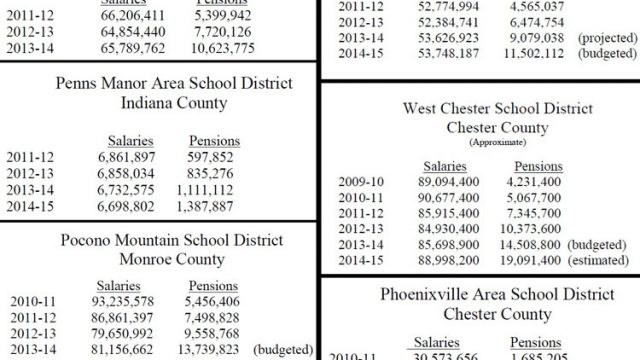School district costs central to PA Republicans’ pension pitch

By Eric Boehm | PA Independent
Pennsylvania’s House Republican leaders hope to vote on a pension overhaul bill this week, and they spent the past week trying to court votes from members who are still on the fence.
Since all politics are local, the group of Republicans pushing the pension bill are trying to show other members how bad things will get for their local school districts in the next few years. It’s not a pretty picture, but the pension bill being offered by state Rep. Mike Tobash, R-Schyulkill, and backed by Gov. Tom Corbett will do little to make it any prettier.
Still, it’s worth looking at some of their numbers to understand the depth of the pension crisis facing Pennsylvania schools.
Pennsylvania has two state pension systems: the State Employees Retirement System and the Public School Employees’ Retirement System, which is funded jointly by the state government and Pennsylvania’s 500 school districts.
In an email to fellow members of the state House, obtained by PA Independent, Tobash and two of his colleagues wrote that school district pension costs offer “compelling evidence” the pension crisis needs to be the state government’s primary focus.
“Even as school district salaries have decreased since 2010/11, pension payments have dramatically increased,” they wrote.
Essentially, school district budgets are being squeezed by pension costs so that districts have to cut spending on teachers who are actually in the classroom to pay for teachers and other employees who have already retired.
CUTTING BACK, PAYING MORE: School districts across Pennsylvania are cutting back salaries to current teachers but being forced to pay millions more in benefits to retirees.
Here’s a few examples offered by Tobash and Co. — in each instance, the school district is paying less in salaries but dramatically more in pensions.
Like we said, it’s not a pretty picture.
The bill Republicans hope to vote on this week would cut pension benefits for future hires by creating a new kind of pension system that shares some elements of a 401(k)-style plan while still being, essentially, a less lucrative defined benefit system for the majority of workers.
But changes to future workers’ benefits will do little, if anything, to relieve the budgetary pressures on school districts. Those new workers will not retire for 30, 40 or perhaps even 50 years, so any savings from giving them lower benefits won’t be recognized until then.
The state Public Employees Retirement Commission said as much when analyzing the Tobash pension bill earlier this month. An actuarial analysis said the bill would save about $11 billion (savings that are based on iffy assumptions, which we covered here) over the next 30 years, but almost all of those savings come in the third decade of that timeline.
The higher costs school districts are being forced to pay this year are a result of a decade of underfunding the state’s two pension plans — something that was done at both the state and school district level.
Those costs are going to keep rising over the next decade unless lawmakers artificially limit pension costs again, which would only exasperate the long-term problem.
Here’s what PSERS says school districts and the state will have to pay into the pension system for the next decade.
PSERS: Though the numbers will vary from district to district, Pennsylvania’s 500 school districts will be responsible for paying roughly half of the total employer cost each year. (Source: PSERS fiscal year 2014-15 employer contribution fact sheet)
Over the next 10 years, pension costs for school districts (and the state) will more than double. And those costs are already baked into the system, part of the $50 billion in unfunded pension debt owed to people who have already retired or are currently working.
Tobash and other GOP leaders pushing the pension bill acknowledge their plan isn’t a “silver bullet.”
“Approving this plan will not mean our job will be complete,” they wrote to fellow members. “It is imperative, then, that we focus on dedicating enough of our budget dollars to making our required contributions to the pension systems which will eventually lead us out of debt.”
Supporters of the plan also tout it as a way to ensure the state never gets into a crisis like this ever again.
As long as the proper payments are made, they might well be correct about that. But it’s far too late to do anything about their main selling point: the rising retirement costs at Pennsylvania’s public schools are here to stay.
Boehm can be reached at Eric@PAIndependent.com and follow @PAIndependent on Twitter for more.







